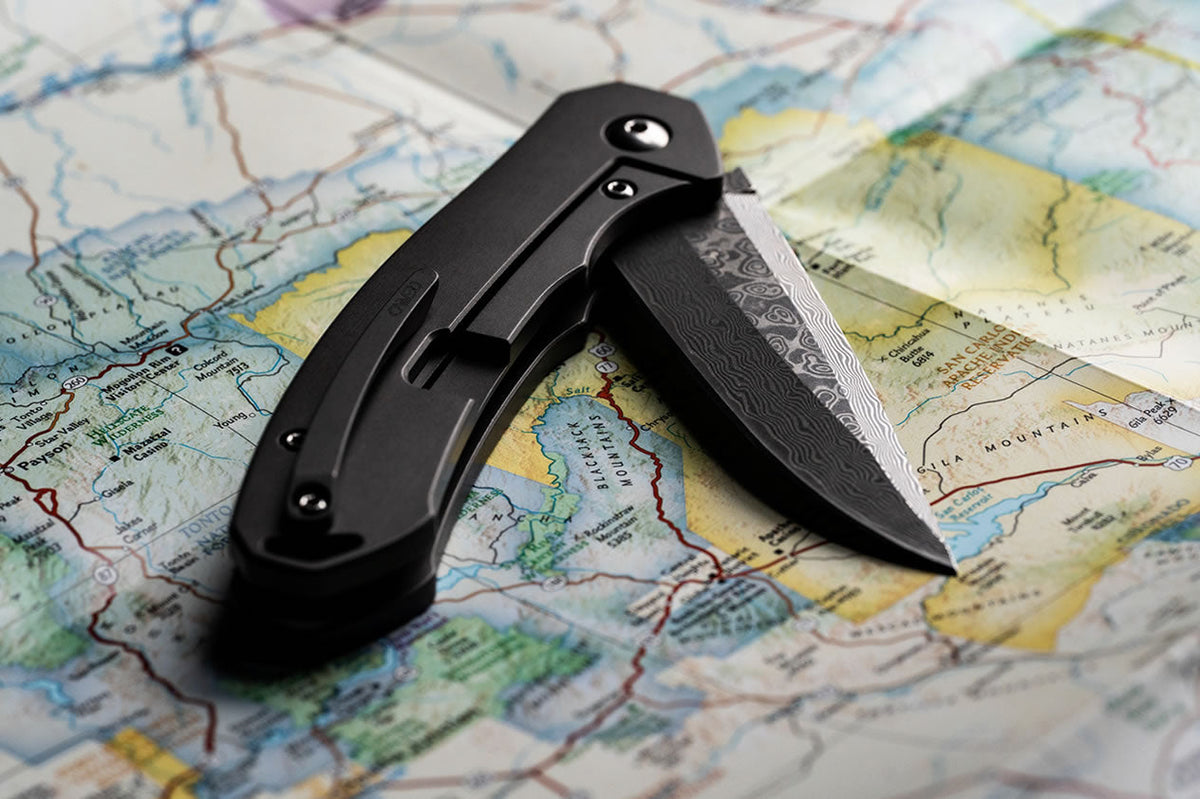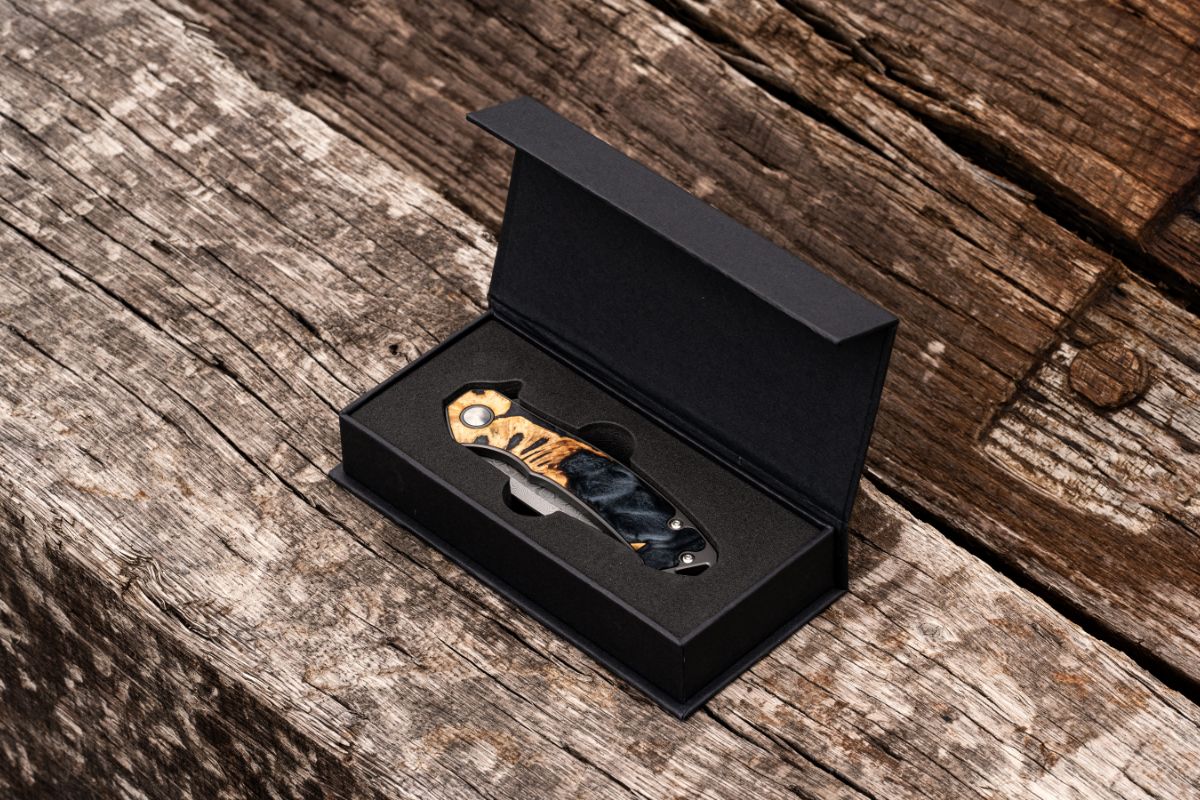
Traveling is one of the greatest forms of education, but it’s just as important to be educated about the guidelines & regulations that apply, especially when traveling via plane. If you’re an everyday carry (EDC) enthusiast, or simply someone who values the right to self-defense, you may regularly carry a pocket knife. And this particular item, more so than a simple bottle of water in some cases, tends to cause confusion amongst even the most frequent flyers. The simple question of: “Can you carry a knife through TSA?” is not met with a simple answer, but rather: “It depends.”
But to avoid any confusion or mishaps with the Transportation Security Administration (TSA), we’re going to set the record straight on traveling with EDC pocket knives. We’ll cover carry-on baggage vs. checked luggage, types of blades that are allowed, blade lengths, and other packing guidelines to ensure a hassle-free trip. On top of that, we’ll explain how knife laws vary by destination, and how to navigate those so that you can comfortably (and legally) carry your knife.
Can I Carry a Pocket Knife on a Plane?
As of 2023, you are prohibited from carrying a pocket knife or any other sharp object in your carry-on baggage. This decision is part of an evolving set of safety regulations & restrictions set by the TSA to keep all passengers, flight crew, and airport employees safe.
This applies to all blades, which includes but is not limited to:
- Pocket knives
- Swiss army knives
- EDC/folding blades
- Multi-tools (with knives)
- Swords
- Switchblades
- Utility knives/box cutters
- Razor blades
- Tactical pens
Despite common misconceptions, there is no such thing as “TSA-friendly knives.”
TSA Knife & Weapons Policies
After the events of 2001, TSA made quick changes in the interest of individual & national security. And though the laws have changed quite a bit over time, the current laws for domestic US air travel prohibit all types of knives, blades, and other sharp objects from being accessible in the cabin.
The most recent change to this policy was in June of 2013, when the TSA decided to reverse a March 2013 decision to allow blades in carry-on luggage that were less than 2.36” long and less than 0.5” wide. Though the decision lasted less than 3 months, this policy excluded knives with fixed or locked blades, including razor blades and box cutters.
TSA prohibits both domestic & international travelers from carrying any sharp objects in their carry-on or hand baggage. Any knives or other sharp objects must be sheathed or securely wrapped and stored in checked baggage to prevent injury to baggage handlers and inspectors. This does not apply to plastic or round-bladed butter knives, which can be stored in your carry-on bag.
There is a clear pattern of misinformation with regards to knives and air travel, which is why pocket knives are one of the most confiscated items at security checkpoints. If you’re not compliant, you may face fines up to $2,250, so be sure to pack your blade in your checked baggage or leave it at home.
International Regulations
While the TSA provides guidelines for air travel within the United States, international regulations can vary widely. If you are traveling from the US to another country, TSA restrictions apply.
However, if you are traveling abroad, and both the departure & arrival locations are outside of the US, different regulations apply. Many countries have their own specific rules regarding what types of knives are permissible aboard flights.
For instance, the UK has a total ban on carrying any sharp objects in carry-ons, and has strict regulations about carrying them in public, even as a part of your EDC gear. The European Union (EU) and many Asian nations have similar policies to the TSA.
Individual Airline Regulations
All airlines must comply with TSA (or international transportation security) regulations; there are no special exceptions for particular airlines. The only exception is if you are traveling via private charter plane, where standard security measures are not implemented.
Where to Pack Your Knife: Carry-On vs. Checked Baggage?
Carry-on Baggage
You are not allowed to pack any knives or other sharp objects in your carry-on baggage. This also applies to your personal items (backpacks, purses, etc.) and your person (pants or jacket pocket). If you wish to travel with a blade of any kind, it must be in your checked baggage, where it’s subject to further inspection.
Checked Baggage
The TSA allows passengers to transport pocket knives in their checked baggage, but there are certain restrictions that must be followed. There are no restrictions on blade length or locking mechanisms when packing your knife. However, it must be encased in a sheath or protective casing. If it’s not, the TSA may open your checked luggage and confiscate the knife. Though it may seem like a strict protocol, the case will prevent your knife from dulling, bending, or breaking during travel.

If you’re traveling with an abnormally large blade or one that appears to have been concealed, TSA may inspect your bag to examine the knife further. In fact, they are legally allowed to break a luggage lock in order to confiscate anything they believe could be a safety risk. You are not required to declare your knife before traveling, but it may help prevent any incidents at the airport, especially if you’ve had issues traveling with that knife before.
Which Knives Can You Bring on a Plane?
Best Knife Types for Travel
There are no TSA-friendly knives, but that shouldn’t stop you from traveling with your EDC knives. Because you can’t carry them on your person or your cabin bag, there are few restrictions that you must adhere to. Ultimately, the type of knife you pack will be based on your needs.
If you’re leaving for a hunting, fishing, or camping trip, consider packing a pocket knife or multi-tool, one that’s easily portable and serves multiple purposes. If you prefer to carry a knife for everyday wear to open packages or perform basic first-aid, consider a small folding knife.
Other EDC Restrictions for Air Travel
Knives, as well as guns, are the most restricted EDC items when it comes to air travel. But as long as you check these items in your luggage, you’ll be able to travel freely. However, you must declare your gun at least 72 hours before takeoff and ensure that you’re in compliance with local gun laws when you land at your destination.
Typically, the only other restricted items are tactical pens, common multi- and self-defense tools, and lighters. However, you are free to carry other EDC items like flashlights, multi-tools with scissors less than 4 inches in length, watches, and wallets.
Beyond the Airport: Check Local Knife Laws Before Arriving
Researching Destination Restrictions
As popular as EDC knives have become across most of the US, certain domestic cities, as well as other nations, have different opinions & laws that apply. If you comply with TSA regulations, but are traveling to a location where certain types of knives are considered illegal, you may have it confiscated anyways.
Check out our guide on Pocket Knife Laws for All 50 States.
As such, you should research your destination before boarding the plane to eliminate any hassle or potential incidents when you arrive. Restrictions vary between cities & countries, but most of these laws limit certain types of opening mechanisms, blade lengths, and even carrying purpose. Always check local government websites & regulations to get the most accurate, up-to-date information.
Cultural Sensitivities & EDC
Carrying a knife isn't just about regulations; it's also about respecting local cultural norms. In many societies, knives and similar tools have deep-rooted cultural or historical significance, which may affect how they're perceived. For instance, while a pocket knife is a practical tool in many Western countries, it might be viewed as a potential weapon in others. Thus, when using or displaying your EDC tool, you should be aware (and discreet, if necessary) of your surroundings.
Best Practices & Tips for Traveling with a Knife
Pre-Travel Checklist
Despite all of the complexities, traveling with a knife is relatively simple. Just follow this packing checklist:
- Secure your pocket knife in a protective sheath or case.
- Place it centrally in your luggage, cushioned by clothes or soft items.
- Attach a label to the case and declare the knife if required by regulations.
- Keep prohibited or suspicious items away from your knife's vicinity in the bag.
- Ensure your packed baggage adheres to airline weight and size limits.
Recovery Methods if Knife is Confiscated
If your pocket knife is confiscated by the TSA, whether it’s at the security checkpoint or the baggage screening, it’s unlikely that it will be returned to you. Items that are marked as “lost” or “found” by TSA will be returned to you, but the policy is a bit unclear when it comes to knives, guns, weapons, and other forbidden goods.
They may turn the knife over to local enforcement if there’s a question about its nature, or immediately dispose of it. There’s also a chance that it may be turned over to state agencies or kept by the TSA to be disposed of through sales, destruction or donations to charity. The money obtained by its sale will be deposited into the US Department of the Treasury, specifically a fund used to pay off the U.S. national debt.
You can attempt to contact the airline carrier or TSA directly to coordinate your knife’s return, but in our experience, there’s not a guarantee that you’ll get it back. As such, it’s best safely checked in your bag or left at home.
Crossing Borders via Land Checkpoints
Generally, land border checkpoints are more relaxed when it comes to searching your vehicle or your person. However, if you are driving from the US to either Mexico or Canada, you are legally allowed to enter those countries with a pocket or utility knife, as long as the blade is shorter than 2.5” to 3”, depending on the country.
If you were unsure about traveling via airplane with a pocket knife, the answer should be clear now. As a general rule of thumb, pack your EDC knives and other goods in your checked luggage to avoid any mishaps. In almost all cases, sharp objects will be confiscated at the security checkpoint should you place them on your person or in your carry-on. The goal of EDC is to be self-sufficient and prepared for anything that life may throw at you, and that goal shouldn’t be put on hold just because you’re boarding a plane.


